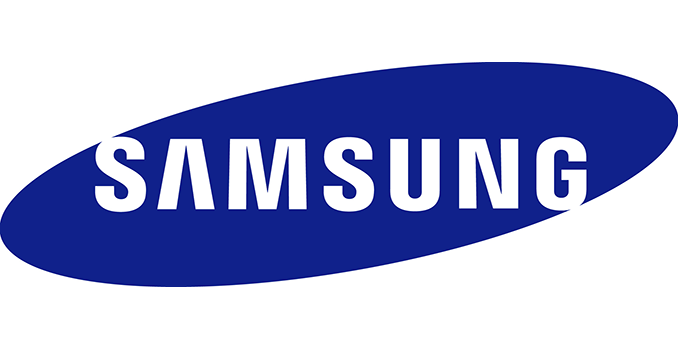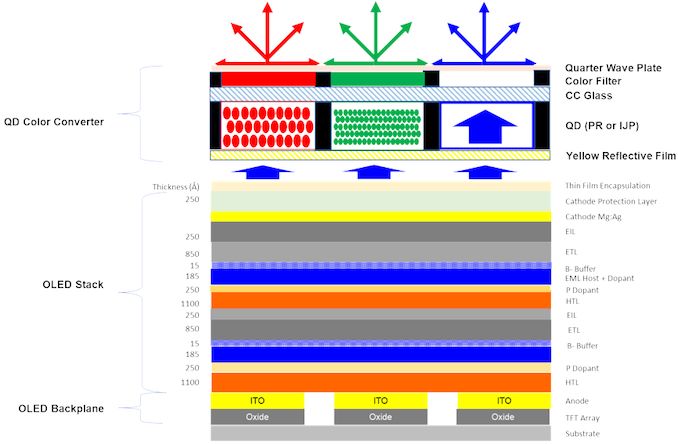Samsung to Invest $11 Billion in QD-OLED Panel Production
by Anton Shilov on October 15, 2019 5:30 PM EST
Samsung Display has announced plans to invest a further ₩13.1 trillion ($11 billion) in the R&D and production of QD-OLED TV panels. The plan includes building up two QD-OLED production lines in South Korea between now and 2025, with the first starting production in 2021. In addition, the company will invest in R&D of quantum dot-enhanced OLED technology, which promises to provide finer colors than today’s OLED displays and televisions.
The first step of Samsung’s QD-OLED plan will be converting its L8 fab in Tangjong, South Korea, from making LCD substrates to QD-OLED substrates. The plant is expected to produce 30 thousand QD-OLED substrates per month starting in Q1 2021. Longer term, Samsung will be converting all of its 8th Generation LCD production facilities to QD-OLED in a bid to increase the number of substrates produced monthly to 100 thousand.
The QD-OLED technology promises to simplify (i.e. lower the cost of) production of OLED-based televisions and monitors, as well as enabling wider color gamuts, which is something expected from next-generation content. Contemporary WOLED panels from LG Display use a blue or white (yellow + blue) OLED emitter stack, and a WRGB color filter system on top with a variety of additional layers behind, between, and ahead of them. By contrast, a QD-OLED panel uses an OLED emitter stack (some believe, with two emitting stacks) with a quantum dot RGB color filter (also called quantum dot color converter, or QDCC) system on top.
Today’s OLED panels feature 22 layers, whereas a QD-OLED panel may cut the number to 13, which means fewer deposition stages, lower material and production costs, and, perhaps, better yield. The QD-OLED technology is still considered to be rather challenging as Samsung has to solve light management issues. Meanwhile, according to Display Supply Chain, one square meter of an QD-OLED panel will cost around $26, whereas one square meter of a contemporary OLED panel costs approximately $95.
Lee Dong-hoon, CEO of Samsung Display, had the following to say:
"Quantum dots are semiconductor particles which luminate close to natural colors. It is the future growth vision of the large display industry. With the investment we will lead the premium display market."
Related Reading:
- Samsung Mulls Suspending South Korea LCD Plant Due to Oversupply
- Samsung Acquires Quantum Dot Tech Company QD Vision
- Samsung’s 8K QLED TV 55-Inch: A More Affordable 8K Ultra-HD TV
- 8K Association Sets Minimal Specs for 8K Ultra-HD TVs
- Sharp to Demonstrate 120-Inch 8K LCD TV & 8K TV with 5G Modem at IFA
- AU Optronics's New 85-Inch 8K LCD TV with 1,024-Zone Backlighting
- Samsung's 2019 QLED UHD TVs: 8K TVs Revamped, 4K TVs Get New Panel & Backlighting
Sources: Reuters, Nanosys, The Investor, Nikkei, DSCC, OLED-Info












42 Comments
View All Comments
s.yu - Tuesday, October 15, 2019 - link
It's not WOLED backlight, it says in the article that it's blue backlight. Quantum dots aren't compatible with white backlight, they require a narrow band light source on a shorter wavelength than their output to be activated, white backlight simply results in bleeding of the other wavelengths that don't aren't absorbed by the dot.Diogene7 - Wednesday, October 16, 2019 - link
@s.yu : Thanks for the clarification.So my understanding is that it is basically a single color (blue) OLED pixel backlight with each OLED pixel driven individually, with on top a color converter to convert the light to Red / Green / Blue (RGB). So it seems a bit similar to LG WOLED technology.
I think I would prefer a 3 RGB OLED sub-pixel (Red sub-pixel, Green sub-pixel, Blue sub-pixel) like it seems to be the case for smartphone size OLED panels : I would think that overall light efficiency should be better (no light loss in converting / filtering), and so it should be better quality and more power efficient, no ? But yes, there would be issues with aging rate of the 3 different colors...
peevee - Wednesday, October 16, 2019 - link
"like it seems to be the case for smartphone size OLED panels"Very unlikely, what is your source for that? OLED screens so far has been less efficient than even LCDs, because they use white light and filter out ~2/3rd of it.
s.yu - Thursday, October 17, 2019 - link
The issue is blue OLED diodes are the least efficient among RGB, but I don't think quantum dots still pose an efficiency issue, either way they should be much more than liquid crystal filters since filters block light and quantum dots rather convert light.Zizy - Wednesday, October 16, 2019 - link
Nope.QDs are the equivalent of color filters present in WOLED or all LCDs (and Samsung uses QD on their highend LCD TVs). These don't filter anything dynamically like LC matrix does in LCD, this is a static filter/converter. So, think about it as LG's WOLED TV with fancier color filters.
Burn in should be the same as WOLED, plus improvements due to higher efficiency, material quality and whatever. Pixel response should be essentially the same as typical OLEDs. These QDs aren't instant in their conversion, but fast enough you shouldn't be able to notice any difference in response time to unfiltered OLED or the ones using simpler color filters.
Blaab1 - Wednesday, October 16, 2019 - link
But does this mean that Samsung was waiting for an improved OLED tech to get into the TV game?Zizy - Wednesday, October 16, 2019 - link
Sure, Samsung might try to spin that in the way you propose, but it wouldn't be really true - just marketing.They went in TV game way back with OLEDs, but LG kicked them out as Samsung's solution didn't scale well - it was too expensive to manufacture. Same as Sony's. They still haven't solved their problems with that approach - it is great for mobile, but TVs are nonexistent beyond some prototypes.
Death666Angel - Wednesday, October 16, 2019 - link
Got it, thanks! :)Diogene7 - Wednesday, October 16, 2019 - link
@Zizy: Thanks for your explanation, it was what I meant to explain that it was a bit similar to LG WOLED but using Quantum Dot (QD) as color converter instead of using color filters.I think I would prefer a 3 RGB OLED sub-pixel (Red sub-pixel, Green sub-pixel, Blue sub-pixel) like it seems to be the case for smartphone size OLED panels : I would think that overall light efficiency should be better (no light loss in converting / filtering), and so it should be better quality and more power efficient, no ?
But I guess it would be more expensive to produce at large area size, which may not make it cost competitive with LG WOLED...
I soooo much want a nearly bezeless laptop (like huawei Matebook X Pro / Microsoft Surface Pro 3 / Samsung Galaxy Book S) & also thin 12.5-inch tablet with the same quality OLED display as Samsung Galaxy Note 10+ : it would be sooo gorgeous !!!
psychobriggsy - Wednesday, October 16, 2019 - link
Each OLED should be self-illuminating, one OLED source per sub-pixel. The quantum-dots or filters are just changing the OLED light colour to the desired red/green/blue. That gives per-pixel lighting. LCD has a single backlight for the entire screen - or in costly devices this is split up into backlighting zones, but that's clearly not as good as this.The fact they're doing this suggests that microLED displays are going to be further off than we hoped, at least for larger screen sizes.